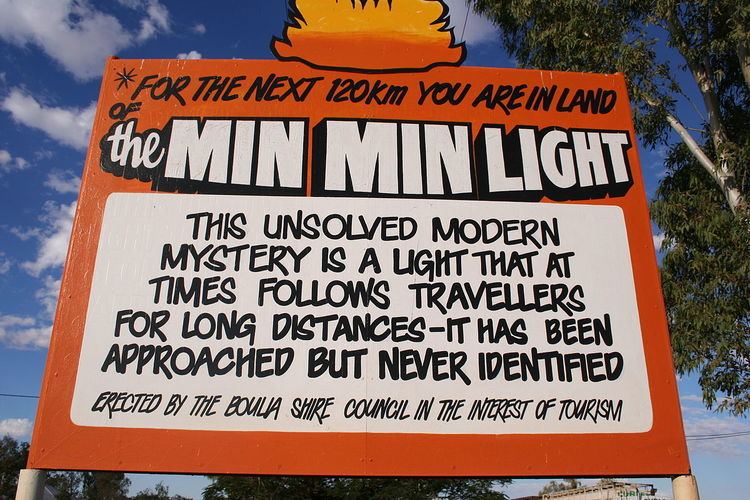 | ||
Min Min is an unusual light phenomenon that has often been reported in outback Australia.
Contents
The name "Min Min" derives from the small settlement of Min Min, located between the outback towns of Boulia and Winton, where the light was observed by a stockman in 1918.
Stories about the lights can be found in Aboriginal myths pre-dating European settlement and have since become part of wider Australian folklore. Indigenous Australians hold that the number of sightings has increased alongside the increasing ingression of Europeans into the outback. According to folklore, the lights sometimes follow or approached people and have disappeared, sometimes very rapidly, when fired upon, only to reappear later on. The first recorded sighting dates to 1838, in the book Six Months in South Australia.
Distribution
Reports of the phenomena are widespread throughout Australia. The lights have been reported from as far south as Brewarrina in western New South Wales, to as far north as Boulia in northern Queensland. The majority of sightings are reported to have occurred in Channel Country. Another district where Min Min lights are often reported is Yunta, South Australia, which is centred within a low-lying basin known for recording extreme cold.
Appearance and behaviour
Accounts of the light appearances vary, though they are most commonly described as being fuzzy, disc-shaped lights that appear to hover just above the horizon. They are often described as being white, though some accounts describe them as changing colour from white to red to green and back again. Some accounts describe them as being dim, others describe them as being bright enough to illuminate the ground under them and to cause nearby objects to throw clearly defined shadows.
Some witnesses describe the light as appearing to approach them several times before retreating. Others report that the lights were able to keep pace with them when they were in a moving motor vehicle.
Hypotheses
Neuroscientist Jack Pettigrew has suggested that the Min Min Light is a form of Fata Morgana. There remains debate over whether it is a real phenomenon, and what the putative source might be. Various explanations have been put forward, ranging from optical illusions and piezoelectrics to luminescent animals.
It is said that anyone who chases the lights and catches them will never return to tell the tale.
The various hypotheses put forward to explain the lights include:
Bioluminescence
It has been hypothesized that the light may be the result of insects swarming that have taken on bioluminescent characteristics after being contaminated by naturally occurring agents found in local fungi, or of species of owl with their own naturally occurring source of bioluminescence. To date, no one has captured or observed an animal with these characteristics. There is also no known bioluminescent source bright enough.
Geophysical lights
A second hypothesis is that the lights are the result of known geophysical phenomena, such as piezoelectrics or marsh gas. Though in many cases lights are reported from areas without favourable geological conditions.
Refraction
A third hypothesis is that the lights are the result of an optical illusion known as a fata morgana, causing remote lights or objects to appear above the horizon. This can cause an object which is normally below the horizontal to be visible.
